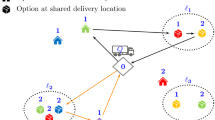Abstract
The problem of minimizing the access time of a requested multimedia (MM) document on a network based environment is addressed. A generalized version of this problem is formulated and retrieval strategies that minimize the access time of the user-requested MM document from a pool of MM servers are proposed. To this end, we design single-installment and multi-installment MM document retrieval strategies, through which the minimization of access time can be carried out. The main idea is to utilize more than one MM server in downloading the requested document. Each server assumes the responsibility of uploading a predetermined portion of the entire document in a particular order. Single- and multi-installment strategies differ in the number of disjoint document pieces each server sends to the client. We first introduce a directed flow graph (DFG) model to represent the retrieval process and generate a set of recursive equations using this DFG. Then, we derive closed-form solutions for the portions of the MM document downloaded from the various servers and the corresponding access time. We present rigorous analysis for these two strategies and show their performance under MPEG-I and MPEG-II video streams playback rates. Their behavior under different network bandwidths is also examined, revealing in-depth information about their expected performance. We also show that in the case of a multi-installment strategy, the access time can be completely controlled by fine tuning the number of installments. Since the number of installments is software tunable, the adaptive nature of the strategies to different channel bandwidths is also demonstrated. Important trade-off studies with respect to the number of servers involved in the retrieval process and the number of installments are presented. In the case of a heterogeneous network employing a single-installment strategy, we prove that the access time is independent of the server sequence used. Illustrative examples are provided for ease of understanding.
Similar content being viewed by others
References
C.C. Bisdikian and B.V. Patel, “Issues on movie allocation in distributed video-on-demand systems,” in Proceeding on IEEE International Conference on Communications, IEEE Communications Society, New York, 1995, pp. 250–255.
C.C. Bisdikian and B.V. Patel, “Cost-based program allocation for distributed multimedia-on-demand systems,” IEEE Multimedia, pp. 62–72, Fall issue, 1996.
M.M. Buddhikot and G. Parulkar, “Distributed data layout, scheduling, and playout control in a large scale multimedia storage server,” Technical Report WUCS-94-33, January 1995.
K.S. Candan, B. Prabhakaran, and V.S. Subrahmanian, “Collaborative multimedia documents: Authoring and presentation,” Technical Report: CS-TR-3596, UMIACS-TR-96-9, University of Maryland, College Park, Computer Science Technical Series Report, January 1996.
K.S. Candan, B. Prabhakaran, and V.S. Subrahmanian, “Retrieval schedules based on resource availability and flexible presentation specifications,” ACM/Springer-Verlag Multimedia Systems Journal, Vol. 6, No. 4, pp. 232–250, 1996.
D. Ferrari, “Client requirements for real-time communication services,” IEEE Communications Magazine, Vol. 28, No. 11, pp. 65–72, 1990.
H. Gajewska, “Argo: A system for distributed collaboration,” ACM Multimedia, pp. 433–440, 1994.
A. Gelman, H. Kobrinski, L.S. Smoot, and S.B. Weinstein, “A store an forward architecture for video on demand servers,” in Proceedings of th International Conference of Communications 1991, Denver-Colorado, IEEE Press, 1991, pp. 842–846.
E. Hwang, B. Prabhakaran, and V.S. Subrahmanian, “Distributed video presentations,” in Proceedings of International Conference on Data Engineering (ICDE'98), Orlando, February 1998.
B. Ozden, R. Rastogi, and A. Siberschatz, “A framework for the storage and retrieval of continuous media data,” in Proceedings of IEEE International Conference on Multimedia Computing and Systems,Washington D.C., May 1995.
C. Papadimitriou, S. Ramanathan, P.V. Rangan, and S. Sampath Kumar, “Multimedia information caching for personalized video-on-demand,” Computer Communications, Vol. 18, No. 3, pp. 204–216, 1995.
P.V. Rangan and H.M. Vin, “Designing file systems for digital audio and video,” in Proceedings of 13th Symposium on Operating System Principles (SOSP'91), Vol. 25, No. 5, pp. 81–94, October 1991.
W.D. Sincoskie, “System architecture for a large scale video on demand service,” Computer Networks and ISDN Systems, Vol. 22, pp. 155–162, 1991.
P. Venkat Rangan, M.H. Vin, and S. Ramanathan, “Designing an on-demand multimedia service,” IEEE Communications Magazine, pp. 56–64, July 1992.
H.M. Vin, A. Goyal, and P. Goyal, “Algorithms for designing multimedia servers,” Computer Communications, Vol. 18, No. 3, pp. 192–203, 1995.
S. Viswanathan and Imielinski, “Metropolitan area video-on-demand service using pyramid broadcasting,” Multimedia Systems, Vol. 4, pp. 197–208, 1996.
Author information
Authors and Affiliations
Rights and permissions
About this article
Cite this article
Veeravalli, B., Barlas, G. Access Time Minimization for Distributed Multimedia Applications. Multimedia Tools and Applications 12, 235–256 (2000). https://doi.org/10.1023/A:1009623825393
Issue Date:
DOI: https://doi.org/10.1023/A:1009623825393




